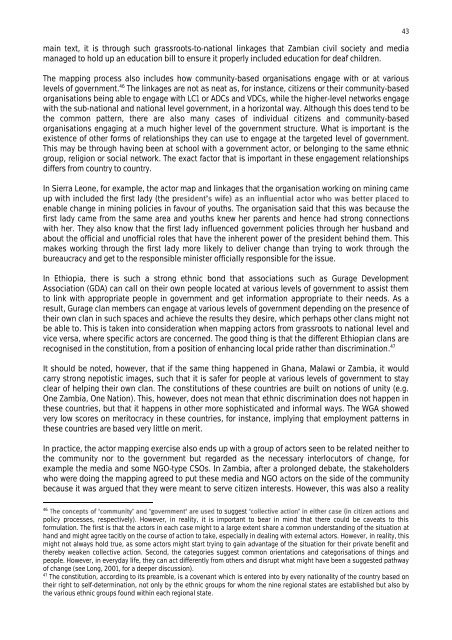Citizen voice and state accountability: Towards ... - Capacity4Dev
Citizen voice and state accountability: Towards ... - Capacity4Dev
Citizen voice and state accountability: Towards ... - Capacity4Dev
- No tags were found...
You also want an ePaper? Increase the reach of your titles
YUMPU automatically turns print PDFs into web optimized ePapers that Google loves.
main text, it is through such grassroots-to-national linkages that Zambian civil society <strong>and</strong> mediamanaged to hold up an education bill to ensure it properly included education for deaf children.The mapping process also includes how community-based organisations engage with or at variouslevels of government. 46 The linkages are not as neat as, for instance, citizens or their community-basedorganisations being able to engage with LC1 or ADCs <strong>and</strong> VDCs, while the higher-level networks engagewith the sub-national <strong>and</strong> national level government, in a horizontal way. Although this does tend to bethe common pattern, there are also many cases of individual citizens <strong>and</strong> community-basedorganisations engaging at a much higher level of the government structure. What is important is theexistence of other forms of relationships they can use to engage at the targeted level of government.This may be through having been at school with a government actor, or belonging to the same ethnicgroup, religion or social network. The exact factor that is important in these engagement relationshipsdiffers from country to country.In Sierra Leone, for example, the actor map <strong>and</strong> linkages that the organisation working on mining cameup with included the first lady (the penable change in mining policies in favour of youths. The organisation said that this was because thefirst lady came from the same area <strong>and</strong> youths knew her parents <strong>and</strong> hence had strong connectionswith her. They also know that the first lady influenced government policies through her husb<strong>and</strong> <strong>and</strong>about the official <strong>and</strong> unofficial roles that have the inherent power of the president behind them. Thismakes working through the first lady more likely to deliver change than trying to work through thebureaucracy <strong>and</strong> get to the responsible minister officially responsible for the issue.In Ethiopia, there is such a strong ethnic bond that associations such as Gurage DevelopmentAssociation (GDA) can call on their own people located at various levels of government to assist themto link with appropriate people in government <strong>and</strong> get information appropriate to their needs. As aresult, Gurage clan members can engage at various levels of government depending on the presence oftheir own clan in such spaces <strong>and</strong> achieve the results they desire, which perhaps other clans might notbe able to. This is taken into consideration when mapping actors from grassroots to national level <strong>and</strong>vice versa, where specific actors are concerned. The good thing is that the different Ethiopian clans arerecognised in the constitution, from a position of enhancing local pride rather than discrimination. 47It should be noted, however, that if the same thing happened in Ghana, Malawi or Zambia, it wouldcarry strong nepotistic images, such that it is safer for people at various levels of government to stayclear of helping their own clan. The constitutions of these countries are built on notions of unity (e.g.One Zambia, One Nation). This, however, does not mean that ethnic discrimination does not happen inthese countries, but that it happens in other more sophisticated <strong>and</strong> informal ways. The WGA showedvery low scores on meritocracy in these countries, for instance, implying that employment patterns inthese countries are based very little on merit.In practice, the actor mapping exercise also ends up with a group of actors seen to be related neither tothe community nor to the government but regarded as the necessary interlocutors of change, forexample the media <strong>and</strong> some NGO-type CSOs. In Zambia, after a prolonged debate, the stakeholderswho were doing the mapping agreed to put these media <strong>and</strong> NGO actors on the side of the communitybecause it was argued that they were meant to serve citizen interests. However, this was also a reality4346to suggestpolicy processes, respectively). However, in reality, it is important to bear in mind that there could be caveats to thisformulation. The first is that the actors in each case might to a large extent share a common underst<strong>and</strong>ing of the situation ath<strong>and</strong> <strong>and</strong> might agree tacitly on the course of action to take, especially in dealing with external actors. However, in reality, thismight not always hold true, as some actors might start trying to gain advantage of the situation for their private benefit <strong>and</strong>thereby weaken collective action. Second, the categories suggest common orientations <strong>and</strong> categorisations of things <strong>and</strong>people. However, in everyday life, they can act differently from others <strong>and</strong> disrupt what might have been a suggested pathwayof change (see Long, 2001, for a deeper discussion).47The constitution, according to its preamble, is a covenant which is entered into by every nationality of the country based ontheir right to self-determination, not only by the ethnic groups for whom the nine regional <strong>state</strong>s are established but also bythe various ethnic groups found within each regional <strong>state</strong>.
















